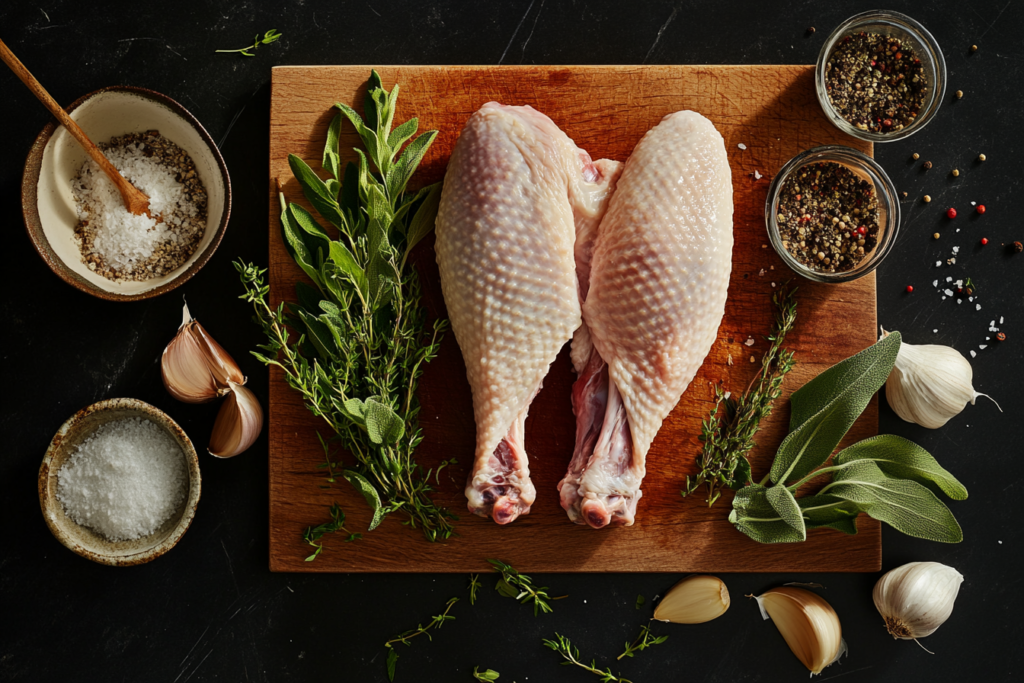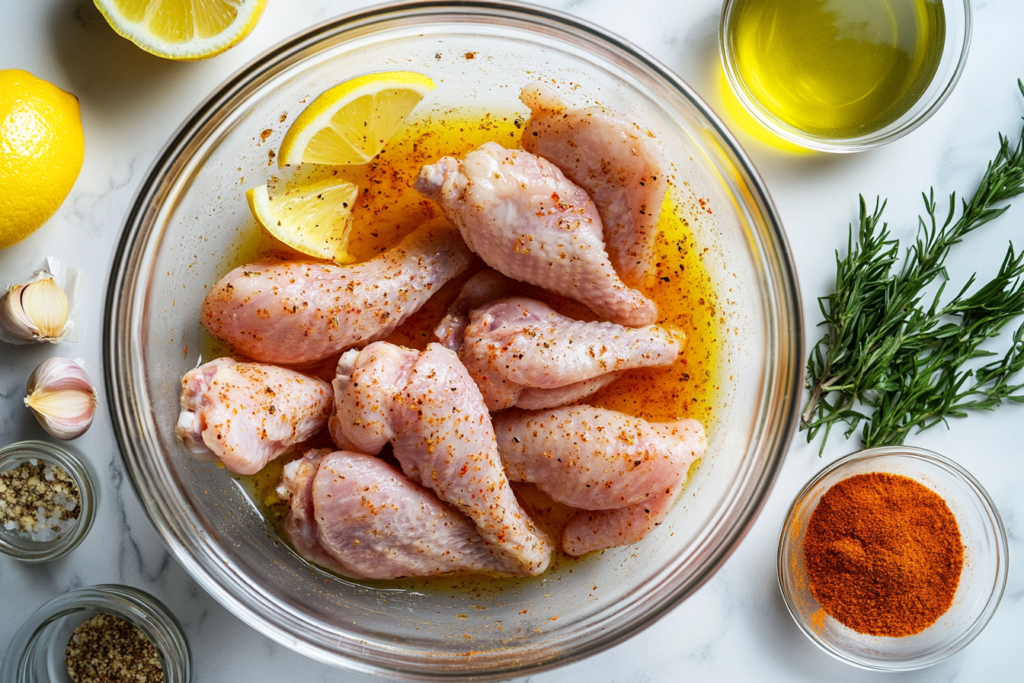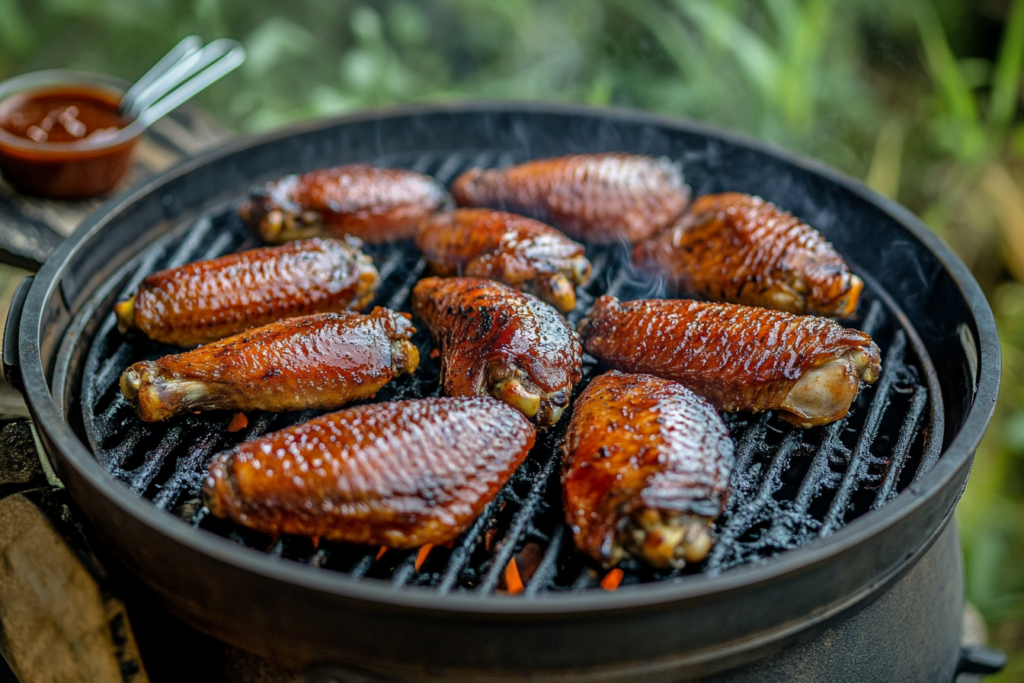Turkey wings are often overlooked in the culinary world, despite being a flavorful and versatile cut of meat. Perfect for creating hearty meals or gourmet dishes, these meaty portions bring rich flavors and endless possibilities to your table. In this guide, we’ll uncover everything from their nutritional value and preparation tips to mouthwatering recipes and side pairings, helping you turn this underrated ingredient into a show-stopping centerpiece.
What Makes Turkey Wings Special?
Hearty and flavorful, turkey wings are larger and more satisfying than their chicken counterparts. Each wing has three parts: the drumette, flat, and wingtip. The drumette is a thick, juicy portion resembling a small drumstick, while the flat offers tender meat between thin bones. The wingtip, though mostly skin and cartilage, adds a delightful crunch when cooked. Thanks to their size and rich flavor, these cuts are perfect for creating both comforting family meals and gourmet dishes.
Anatomy and Features
Let’s break down the turkey wing. The drumette is the meatiest part, resembling a miniature turkey drumstick. It’s thick, juicy, and packed with flavor. The flat, also called the midsection, is thinner but equally delicious, with meat layered around two thin bones. Lastly, there’s the wingtip, which is mostly skin and cartilage but can add a nice crunch when cooked properly.
This anatomy makes turkey wings incredibly versatile. You can separate the parts for specific recipes or cook them whole for a more rustic presentation. Plus, the bones and skin contribute to a rich depth of flavor when slow-cooked or roasted.

Nutritional Highlights
If you’re looking for a protein-packed meal, turkey wings deliver. A single serving provides a hefty dose of protein, essential for muscle repair and overall health. But that’s not all. They are also rich in:
- Iron: Supports red blood cell production and energy levels.
- Zinc: Strengthens the immune system and supports wound healing.
- B Vitamins: Particularly B6 and B12, which are crucial for brain health and energy metabolism.
However, like any food, moderation is key. The wings can be high in fat, especially if the skin is left on, but choosing healthier cooking methods (like baking or grilling) can help manage calorie content while preserving the flavor.
Choosing High-Quality Turkey Wings
Shopping for turkey wings might seem straightforward, but a few tips can ensure you’re getting the best quality meat.
Fresh or Frozen Options
When it comes to fresh vs. frozen, both options have their pros and cons. Fresh turkey wings often have a richer flavor and better texture but may be harder to find and more expensive. Frozen wings, on the other hand, are more convenient and budget-friendly. Just make sure to check the packaging for freezer burn, which can affect the quality.
Tips for Quality Checks
Whether fresh or frozen, quality is key. Look for turkey wings with firm, moist skin and no off-putting odors. The meat should have a pale pink or light beige color—avoid anything that looks discolored or slimy. If you’re buying frozen wings, make sure they’re solidly frozen with no signs of ice crystals or leaks in the packaging.
How to Prep Turkey Wings Like a Pro
Preparing these cuts properly is the foundation of a delicious dish. Whether you’re aiming for a casual family dinner or an impressive meal for guests, the steps to prep wings are straightforward but crucial. From thorough cleaning to selecting the perfect marinade, let’s explore the techniques that ensure flavorful and tender results.
Cleaning Essentials
Before you even think about seasoning or cooking, cleaning your turkey wings is a must. Start by rinsing the wings under cold running water. This helps to remove any residue or bone fragments that might be present. For an extra step of cleanliness, some cooks prefer to soak the wings in a mixture of water, vinegar, and salt for about 15 minutes before rinsing again.
While cleaning, make sure to trim off any excess fat or skin that you don’t want. A sharp kitchen knife or kitchen shears will make this job much easier. Remember, hygiene is crucial—sanitize your hands, utensils, and surfaces after handling raw poultry.

Marinating Secrets
Now comes the fun part—marinating. Marinating wings is like giving them a flavor makeover, ensuring every bite is juicy and delicious. A good marinade typically includes four key elements:
- Acid: Ingredients such as vinegar, lemon juice, or yogurt work to tenderize the meat.
- Oil: Olive oil or other neutral oils keep the wings moist during cooking.
- Seasonings: Salt, pepper, garlic, and your choice of herbs and spices for flavor.
- Sweetness (Optional): Honey, brown sugar, or maple syrup can add a hint of sweetness.
Combine these elements in a large bowl or resealable bag, then add the turkey wings. Make sure each wing is well-coated, then let them marinate in the fridge for at least 2-4 hours—or even overnight for maximum flavor.
If you’re short on time, dry rubs are a quicker alternative. Simply coat the wings with a blend of your favorite spices and let them rest for 30 minutes before cooking.
Popular Cooking Methods for Turkey Wings
Once your wings are ready, it’s time to start cooking! These cuts are incredibly versatile—you can bake them for a crispy finish, grill for a smoky flavor, fry for a rich indulgence, or even air-fry for a lighter option. No matter your mood or dietary preference, there’s a cooking method to suit your taste.
Baking Turkey Wings
Baking is one of the easiest and healthiest ways to cook this recipe. It allows the meat to cook evenly while locking in moisture.
- Preheat your oven to 375°F (190°C).
- Line a baking sheet with foil and set a wire rack on top. This setup ensures even cooking and allows excess fat to drip off.
- Arrange the marinated or seasoned turkey wings on the rack.
- Bake for about 45 minutes to 1 hour, flipping the wings halfway through to ensure a crispy, golden exterior.
For extra crispiness, crank up the oven to 425°F (220°C) for the last 10 minutes.
Grilled Perfection
If you’re a fan of smoky, charred flavors, grilling is the way to go. Perfect for summer barbecues, grilled turkey wings are both flavorful and visually appealing.
- Preheat the grill to medium heat and lightly oil the grates to prevent sticking.
- Place the turkey wings on the grill and cook for 20-25 minutes, turning occasionally.
- Use a meat thermometer to confirm the internal temperature reaches 165°F (74°C).
To enhance the smoky flavor, you can add wood chips or baste the wings with barbecue sauce during the last 5 minutes of grilling.

Crispy Fried Wings
When it comes to indulgence, nothing beats the crispy goodness of fried turkey wings.
- Heat vegetable or peanut oil in a deep fryer or large skillet to 350°F (175°C).
- Pat the wings dry with paper towels to prevent oil splatter.
- Dredge the wings in seasoned flour or batter for an extra crispy coating.
- Fry the wings in small batches for 8-10 minutes or until golden brown and cooked through.
Drain the wings on a paper towel-lined plate and serve immediately with your favorite dipping sauce.
Must-Try Turkey Wing Recipes
Now that you’ve covered the essentials of preparation and cooking, it’s time to dive into some truly delicious recipes. Whether you’re craving classic comfort food or bold, spicy flavors, these ideas will transform this versatile cut of meat into the centerpiece of a memorable meal.
Southern-Style Turkey Wings
Nothing says comfort food quite like Southern-style turkey wings. This recipe is a favorite for its hearty, homey flavors and fall-off-the-bone tenderness.
Ingredients:
- 4 turkey wings, cleaned and trimmed
- 1 large onion, sliced
- 2 cups chicken broth
- 2 tablespoons olive oil
- 1 teaspoon garlic powder
- 1 teaspoon onion powder
- 1 teaspoon paprika
- Salt and pepper to taste
Directions:
- Preheat your oven to 350°F (175°C).
- Season the turkey wings with garlic powder, onion powder, paprika, salt, and pepper.
- Heat olive oil in a skillet over medium heat and sear the wings until browned on all sides.
- Place the wings in a baking dish, add sliced onions on top, and pour chicken broth over everything.
- Cover tightly with foil and bake for 2 hours, or until the wings are tender.
Serve with collard greens and cornbread for a true Southern feast!
Spicy Buffalo Wings
If you’re a fan of buffalo chicken wings, you’ll love this fiery twist with turkey wings. These wings are perfect for game nights or casual gatherings.
Ingredients:
- 4 turkey wings, cleaned and trimmed
- 1 cup hot sauce (like Frank’s RedHot)
- 4 tablespoons unsalted butter, melted
- 1 teaspoon garlic powder
- 1 teaspoon cayenne pepper (optional for extra heat)
Directions:
- Preheat your oven to 400°F (200°C).
- Mix hot sauce, melted butter, garlic powder, and cayenne pepper in a bowl.
- Toss the turkey wings in the sauce mixture until fully coated.
- Place the wings on a wire rack positioned over a baking sheet.
- Bake for 45-50 minutes, flipping halfway through.
Serve with ranch or blue cheese dressing and celery sticks for the ultimate buffalo wing experience.
Herb-Roasted Delight
Looking for a healthier, more refined option? Herb-roasted wings are flavorful and elegant, making them a fantastic choice for a cozy dinner or a festive holiday spread.
Ingredients:
- 4 turkey wings, cleaned and trimmed
- 3 tablespoons olive oil
- 2 tablespoons fresh rosemary, chopped
- 2 tablespoons fresh thyme, chopped
- 4 garlic cloves, minced
- 1 teaspoon lemon zest
- Salt and pepper to taste
Directions:
- Preheat your oven to 375°F (190°C).
- Combine olive oil, rosemary, thyme, garlic, lemon zest, salt, and pepper in a small bowl.
- Rub the herb mixture all over the wings.
- Place the wings on a roasting pan and bake for 50-60 minutes, or until golden brown and cooked through.
Pair these wings with roasted vegetables or a fresh salad for a wholesome meal.
Side Dishes to Pair with Turkey Wings
Turkey wings are versatile enough to pair with a wide range of side dishes. From classic comfort foods to lighter, more creative options, there’s a side dish for every mood and occasion.
Traditional Pairings
For a traditional spread, you can’t go wrong with:
- Collard Greens: Slow-cooked greens seasoned with smoked turkey or ham.
- Mashed Potatoes: Creamy, buttery mashed potatoes that soak up all the delicious turkey wing juices.
- Cornbread: Sweet and crumbly cornbread is a perfect complement.
These classic pairings evoke the warmth and nostalgia of a home-cooked meal.
Creative Side Dishes
If you’re looking to mix things up, try these creative pairings:
- Quinoa Salad: A light, nutty salad with cranberries, almonds, and a citrus vinaigrette.
- Roasted Brussels Sprouts: Tossed in olive oil, garlic, and balsamic glaze for a tangy twist.
- Sweet Potato Fries: Crispy, oven-baked fries that add a touch of sweetness to your plate.
These sides bring new flavors and textures to the table, making your turkey wings even more memorable.
Tips for Storing and Reheating Turkey Wings
Leftovers are a blessing, especially when it comes to turkey wings. With the right storage and reheating techniques, you can enjoy your wings the next day without sacrificing their flavor or texture.
How to Store Cooked Turkey Wings
Proper storage is essential to keep your turkey wings fresh and safe to eat.
- Cool Before Storing: Allow the cooked wings to cool to room temperature before refrigerating. Placing hot food in the fridge can cause condensation and increase the risk of bacterial growth.
- Use Airtight Containers: Store your turkey wings in airtight containers or resealable bags to prevent moisture loss and keep out unwanted odors.
- Refrigeration: Place the wings in the refrigerator if you plan to eat them within 3-4 days.
- Freezing: For longer storage, freeze the wings. Wrap them tightly in aluminum foil or plastic wrap and place them in a freezer-safe container or bag. Properly stored, frozen turkey wings can last up to 3 months.
Label your containers with the date to track how long they’ve been stored.
Reheating Techniques
Reheating turkey wings the right way ensures they remain juicy and flavorful. Here are some foolproof methods:
- Oven: Preheat your oven to 350°F (175°C). Place the turkey wings in an oven-safe dish, add a splash of broth or water to keep them moist, and cover with foil. Heat for 20-25 minutes or until warmed through.
- Microwave: If you’re in a hurry, use the microwave. Place the wings on a microwave-safe plate, cover them with a damp paper towel, and heat in 30-second intervals until hot. This method is quick but may compromise crispiness.
- Air Fryer: For crispy reheated wings, the air fryer is your best bet. Preheat it to 375°F (190°C) and heat the wings for 6-8 minutes.
- Stovetop: Reheat in a skillet over medium heat with a bit of oil or broth. Cover the skillet to retain moisture and heat for 8-10 minutes, flipping occasionally.
Avoid reheating turkey wings more than once to preserve quality and ensure food safety.
Health Considerations and Alternatives
Turkey wings are a delicious option, but they’re not always the healthiest choice depending on how they’re prepared. Here, we’ll explore ways to make them healthier and some alternatives if turkey wings aren’t an option for you.
Healthier Cooking Alternatives
If you’re watching your calorie or fat intake, consider these healthier cooking methods:
- Air Frying: This method uses minimal oil while delivering crispy, flavorful wings.
- Steaming: Steamed turkey wings retain their natural juices and nutrients, making them a great option for a light, wholesome meal.
- Roasting: Roasting with minimal oil and plenty of herbs and spices is a flavorful yet healthy way to prepare turkey wings.
Removing the skin before cooking can significantly reduce fat content without sacrificing flavor. You can also experiment with marinades that rely on herbs, citrus, and spices rather than sugary or oily ingredients.
Substitutes for Turkey Wings
If turkey wings aren’t available or you’re catering to dietary restrictions, there are plenty of substitutes:
- Chicken Wings: Smaller and lighter, chicken wings are a great alternative for most turkey wing recipes.
- Turkey Drumsticks: If you want the same flavor profile but more meat, turkey drumsticks are an excellent choice.
- Plant-Based Options: For vegetarians or vegans, meat substitutes like seitan or jackfruit can mimic the texture of the wings when seasoned and cooked properly.
As you dive into the world of turkey wings, don’t miss exploring complementary dishes like Philly Chicken Cheesesteak Recipe to pair with your wings, or learn how to master flavorful sides with tips from Dense Bean Salads: Health Benefits. For those seeking perfect seasoning inspiration, check out Gordon Ramsay’s Salmon Seasoning Tips—a guide that could influence your marinade game for turkey wings. These resources are tailored to help you create unforgettable meals that combine taste and nutrition seamlessly.
Frequently Asked Questions (FAQs)
To wrap things up, let’s address some common questions about turkey wings.
H3: Are turkey wings good to eat?
Yes, turkey wings are not only delicious but also packed with protein and essential nutrients like iron and zinc. Their rich flavor and versatility make them a favorite for hearty meals.
How long do it take for turkey wings to cook?
typically take 45-60 minutes to bake at 375°F (190°C). Grilling or frying takes around 20-30 minutes, depending on size and cooking method. Always ensure the internal temperature reaches 165°F (74°C).
Why do you soak turkey wings in vinegar?
Soaking turkey wings in vinegar helps remove any odors and acts as a natural tenderizer. It also ensures the wings are clean and ready for marination or seasoning.
Why are my turkey wings so tough?
Tough turkey wings are usually the result of undercooking or cooking at too high a temperature. Slow-cooking methods like baking at lower temperatures allow the connective tissue to break down, making the meat tender.
Conclusion: Why Turkey Wings Are a Versatile and Delicious Option
Turkey wings are more than just an alternative to traditional poultry cuts—they’re a culinary canvas. With their rich flavor, versatility, and nutritional benefits, they can elevate any meal, whether it’s a casual dinner or a holiday feast. From Southern-style comfort food to spicy buffalo wings, there’s a recipe and cooking method to suit every palate.
So why not give turkey wings a try? With the tips, recipes, and techniques in this guide, you’re well-equipped to create a dish that’s not just satisfying but memorable. Turkey wings aren’t just food—they’re an experience.

